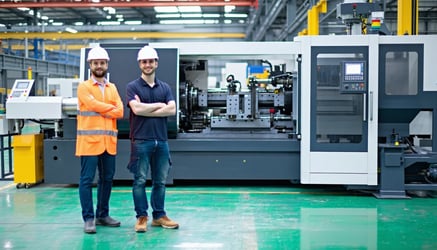In the electrical and electronics (E&E) industry, precision is non-negotiable. Whether you’re injection molding components like connectors or extruding wire insulation and film for sensitive devices, even minor contamination can result in rejected parts, failed electrical performance, or damaged customer relationships.
Black specks in a connector housing. A faint streak in transparent film. A trace of carbon in a conductive housing. These seemingly small issues can create major quality concerns. That’s why clean production isn’t just ideal—it’s essential.
And in this industry, it all starts with your purging strategy.
The Role of Purging in Electronics Plastics Processing
Plastics used in E&E applications often include challenging materials—flame-retardant compounds, glass-filled nylons, high-clarity PC, and antistatic blends, just to name a few. These resins are valuable, but they’re also prone to degradation and buildup during processing. Over time, this leads to discoloration, streaking, black specs, or inconsistent flow—all of which can compromise part performance.
For processors juggling short runs, tight tolerances, and color or material changes, failing to purge thoroughly between jobs can quietly sabotage production quality. The real cost shows up in scrap rates, unscheduled downtime, or worse—customer rejections.
Mechanical vs. Chemical: Choosing the Right Purge
There’s no universal purging solution, but understanding your process type helps determine the right approach.
If you're injection molding electronic components—connectors, enclosures, switches—then mechanical purging compounds are usually your best bet. These purges rely on pressure and screw movement to dislodge contamination. They’re effective at removing previous materials or pigments, especially in tight spaces like runners or gating systems. Because they’re low-residue, they’re safe for critical parts that require visual clarity or dimensional accuracy.
On the extrusion side, the challenges look different. Wire insulation lines and blown film extrusion don’t have the same screw movement or agitation, which makes chemical purging compounds more effective. These compounds chemically react at processing temperature to loosen buildup and contaminants in areas that mechanical purges can’t easily reach—like dies, screens, or long barrels. For extruders dealing with flame-retardant additives, color streaks, or gels, chemical purging provides a deeper clean.
Shutdown and Startup: Where Contamination Starts
Changeovers often get all the attention, but contamination is just as likely to come from poor shutdown practices. Many processors, especially during shift changes or weekends, leave resin in the barrel and power down the line. When that resin sits hot—or cools and reheats—it begins to degrade. That’s where black specs and streaks start to form.
The best practice is to run a purge before shutdown and use a sealing purge to fill the system. This keeps oxygen out, stabilizes the machine, and makes for a faster, cleaner startup when the next shift begins. It also extends screw life and helps avoid emergency screw pulls that drain time and labor.
Avoiding Common Pitfalls in E&E Processing
One common misstep is using regrind or the next production resin to “clean” the machine. While this may seem cost-effective, production resins are not designed to clean. In fact, they often make matters worse by layering over previous resins and pigments rather than removing them. That buildup eventually flakes off during a future run, leading to sudden and unpredictable contamination.
Another issue is inconsistency across shifts. If purging procedures aren’t standardized, one operator might get a clean transition while another inherits residue that wasn’t fully cleared. Establishing SOPs for purging—including purge type, temperature ranges, and shutdown protocols—helps ensure consistency across the board.
Final Thoughts
In electronics manufacturing, clean production isn’t optional—it’s expected. Every part you mold or extrude plays a role in a larger system, and even minor contamination can create big problems downstream.
Whether you're running a 32-cavity connector mold or an extrusion line for wire jacketing, investing in a proper purging process yields significant benefits. Mechanical purges keep molders agile and precise. Chemical purges help extruders stay clean and consistent. Preventive shutdown procedures help every processor avoid downtime and unexpected defects.
Cleaner machines make better parts—and in this industry, better parts protect your reputation.
Ready to see the difference Asaclean® can make in your production? Request a free sample today and experience how our purging compounds can enhance your color change efficiency, reduce waste, and improve your manufacturing process. Our team of experts is here to guide you through the process and help you achieve the best results. Contact us now to get started!

Tom Hanvey is the Associate Director of Marketing & Sustainability at Plastics North America. Before joining APNA, he worked as the Senior Marketing Manager for Asaclean Purging Compounds. He's worked in the plastics industry for over 10 years and focuses on recyclable resins and on the inbound marketing side, providing easy-to-digest content to processors looking for an edge on their competition.








Comments